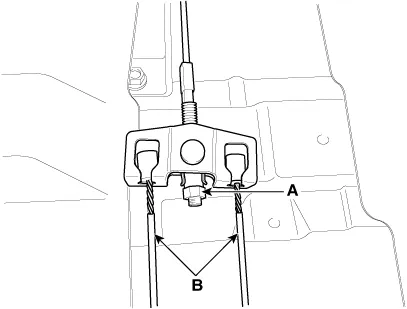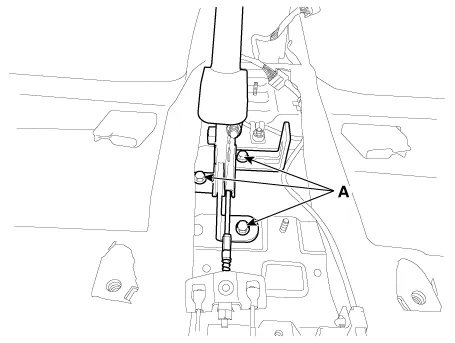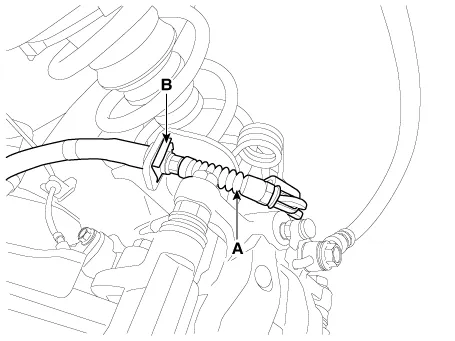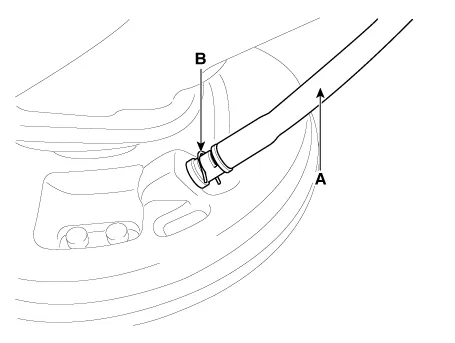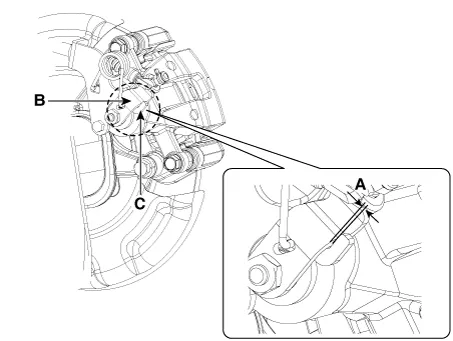Kia Rio: Brake System / Parking Brake Assembly
Components and components location
| Components |
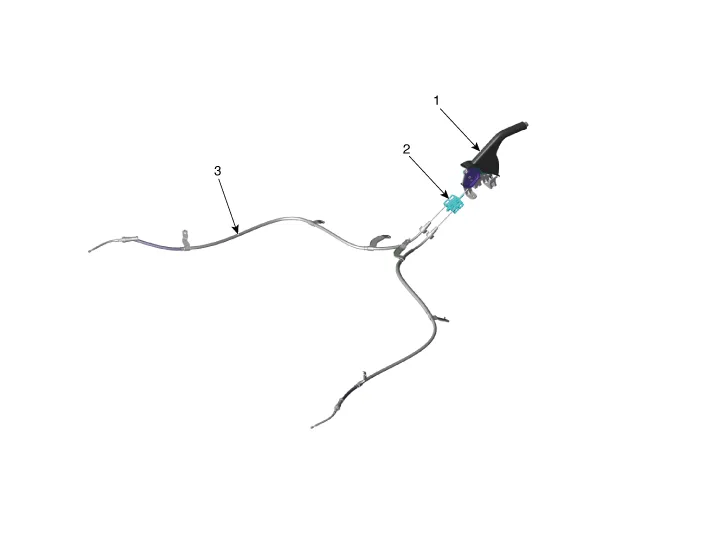
| 1. Parking brake lever 2. Equalizer assembly |
3. Rear parking brake cable
|
Repair procedures
| Removal |
| Rear Disc Brake Type |
The parking brake cables must not be bent or distorted. This will lead to stiff operation and premature failure. |
| 1. |
Remove the floor console. (Refer to Body - "Floor Console Assembly") |
| 2. |
Disconnect the connector (A) of parking brake switch.
|
| 3. |
Loosen the adjusting nut (A) and the parking brake cables (B).
|
| 4. |
Remove the parking brake lever assembly after removing the bolts (A).
|
| 5. |
Raise the vehicle, and make sure it is securely supported. |
| 6. |
Remove the rear tire and wheel. |
| 7. |
Remove the parking brake cable (A), after removing the clip (B).
|
| 8. |
Loosen the parking brake cable bracket bolts and remove the parking brake cable. |
| Rear Drum Brake Type |
The parking brake cables must not be bent or distorted. This will lead to stiff operation and premature failure. |
| 1. |
Remove the floor console. (Refer to Body - "Floor Console Assembly") |
| 2. |
Disconnect the connector (A) of parking brake switch.
|
| 3. |
Loosen the adjusting nut (A) and the parking brake cables (B).
|
| 4. |
Remove the parking brake lever assembly after removing the bolts (A).
|
| 5. |
Raise the vehicle, and make sure it is securely supported. |
| 6. |
Remove the rear tire and wheel. |
| 7. |
Remove the parking brake cable from the brake shoe. (Refer to Brake System - "Rear drum brake") |
| 8. |
Remove the parking brake cable (A), after removing the clip (B).
|
| 9. |
Loosen the parking brake cable bracket bolts and remove the parking brake cable. |
| Installation |
| Rear Disc Brake Type |
| 1. |
Install the parking brake cable. |
| 2. |
Install the parking brake cable (A), and then install the clip (B).
|
| 3. |
Install the rear tire and wheel. |
| 4. |
Install the parking brake lever assembly.
|
| 5. |
Apply a coating of the specified grease to each sliding parts (A) of the ratchet plate or the ratchet pawl.
|
| 6. |
Install the parking brake cable adjuster, then adjust the parking brake lever stroke by turning adjusting nut (A).
|
| 7. |
Release the parking brake lever fully, and check that parking brakes do not drag when the rear wheels are turned. Readjust if necessary. |
| 8. |
Make sure that the parking brakes are fully applied when the parking brake lever is pulled up fully. |
| 9. |
Reconnect the connector (A) of parking brake switch.
|
| 10. |
Install the floor console. (Refer to Body - "Floor Console Assembly") |
| Rear Drum Brake Type |
| 1. |
Install the parking brake cable. |
| 2. |
Install the parking brake cable (A), and then install the clip (B).
|
| 3. |
Remove the brake shoe. (Refer to Brake System - "Rear Drum Brake") |
| 4. |
Install the rear tire and wheel. |
| 5. |
Install the parking brake lever assembly.
|
| 6. |
Apply a coating of the specified grease to each sliding parts (A) of the ratchet plate or the ratchet pawl.
|
| 7. |
Install the parking brake cable adjuster, then adjust the parking brake lever stroke by turning adjusting nut (A).
|
| 8. |
Release the parking brake lever fully, and check that parking brakes do not drag when the rear wheels are turned. Readjust if necessary. |
| 9. |
Make sure that the parking brakes are fully applied when the parking brake lever is pulled up fully. |
| 10. |
Reconnect the connector (A) of parking brake switch.
|
| 11. |
Install the floor console. (Refer to Body - "Floor Console Assembly") |
| Parking Brake Lever Stroke Adjustment |
| 1. |
Remove the floor console. (Refer to Body - "Floor Console Assembly") |
| 2. |
Apply a coating of the specified grease to each sliding parts (A) of the ratchet plate or the ratchet pawl.
|
| 3. |
Install the parking brake cable adjuster, then adjust the parking brake lever stroke by turning adjusting nut (A).
|
| 4. |
Release the parking brake lever fully, and check that parking brakes do not drag when the rear wheels are turned. Readjust if necessary. |
| 5. |
Make sure that the parking brakes are fully applied when the parking brake lever is pulled up fully. |
| 6. |
Install the floor console. (Refer to Body - "Floor Console Assembly") |
| Parking Brake Shoe Clearance Adjustment |
Rear Drum Brake Type
| 1. |
Depress the brake pedal several times to set the self-adjusting brake.
|
Rear Disc Brake Type
Re-setting of the parking brake is necessary after overhauling the caliper body, or if the brake calipers, housing, parking brake cable or brake discs have been changed. |
| 1. |
Remove the floor console to reach the adjusting nut. |
| 2. |
Loosen the parking brake cable until both operating levers rest in fully off position. |
| 3. |
Bring the brake pads in their operating position by pressing the brake pedal down several times until there is resistance. |
| 4. |
Tension the parking brake cable by tightening the adjusting nut, until the operating levers on both calipers lift from the stop, up to a distance of (A) between operating lever (B) and stopper (C).
|
| 5. |
Parking brake lever in the car must be in fully loosened position. |
| 6. |
If the handbrake cables where changed, actuate the parking brake a few times with maximum force to stretch the parking brake cables, and then control adjusting as above. |
| 7. |
Check the wheels of their free operation. |
| 8. |
Install the floor console. (Refer to Body - "Floor Console Assembly") |
| 9. |
Test drive. |
Components and components location Components 1. Brake pedal member assembly 2. Stop lamp switch 3. Brake pedal arm Schematic diagrams Schematic Diagram System circuit diagram Terminal function Terminal Description 1 IGN1 2 Engine Control Module (ECM) 3 B+ 4 Stop Lamp Troubleshooting Troubleshooting 1.
Components and components location Components 1. ABS control module 2. Front wheel speed sensor 3. Rear wheel speed sensor Description and operation Description This specification applies to HCU(Hydraulic Control Unit) and ECU(Electronic Control Unit) of the HECU.
Other information:
Kia Rio 2017-2023 YB Service Manual: Smart Key Diagnostic
Repair procedures Inspection Self Diagnosis With Scan Tool It will be able to diagnose defects of SMART KEY system with KDS/GDS quickly. KDS/GDS can operates actuator forcefully, input/output value monitoring and self diagnosis. The following three features will be major problem in SMART KEY system.
Kia Rio 2017-2023 YB Service Manual: Compressor
Description and operation Description The compressor is the power unit of the A/C system. It is located on the side of engine block and driven by a V-belt of engine. The compressor changes the low pressure and low temperature refrigerant gas into the high pressure and high temperature refrigerant gas.
Categories
- Manuals Home
- Kia Rio Owners Manual
- Kia Rio Service Manual
- Drive Belt
- System setting and activation
- Specifications & Consumer information
- New on site
- Most important about car



